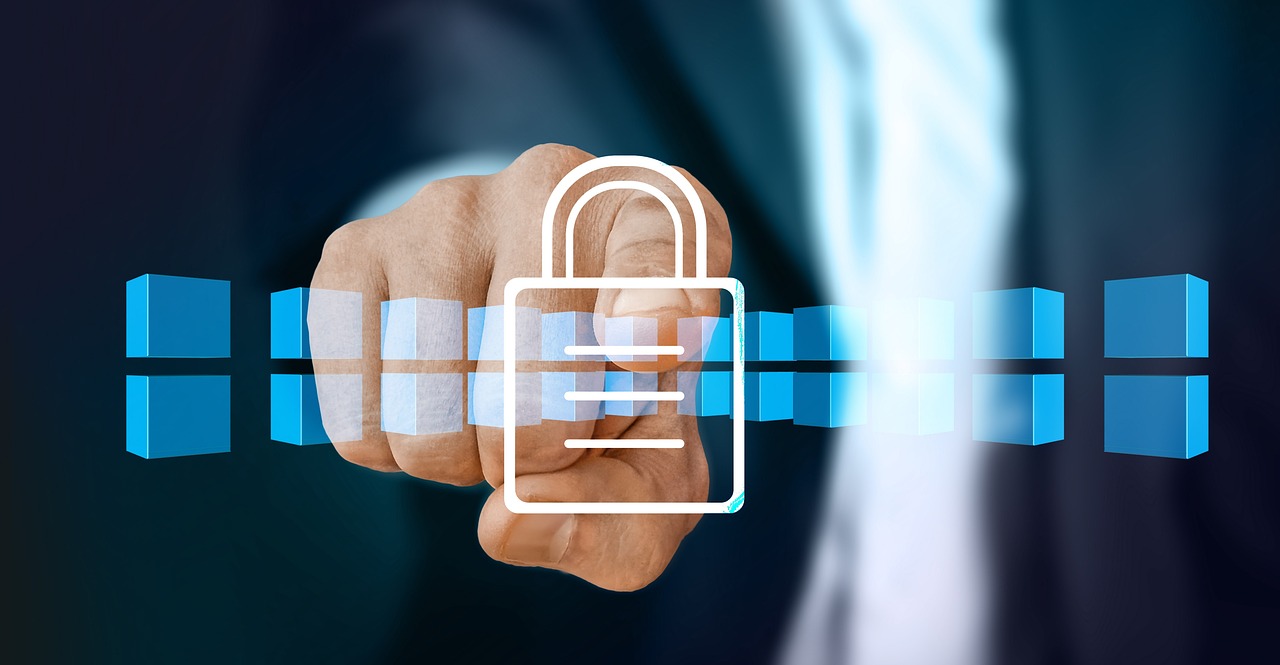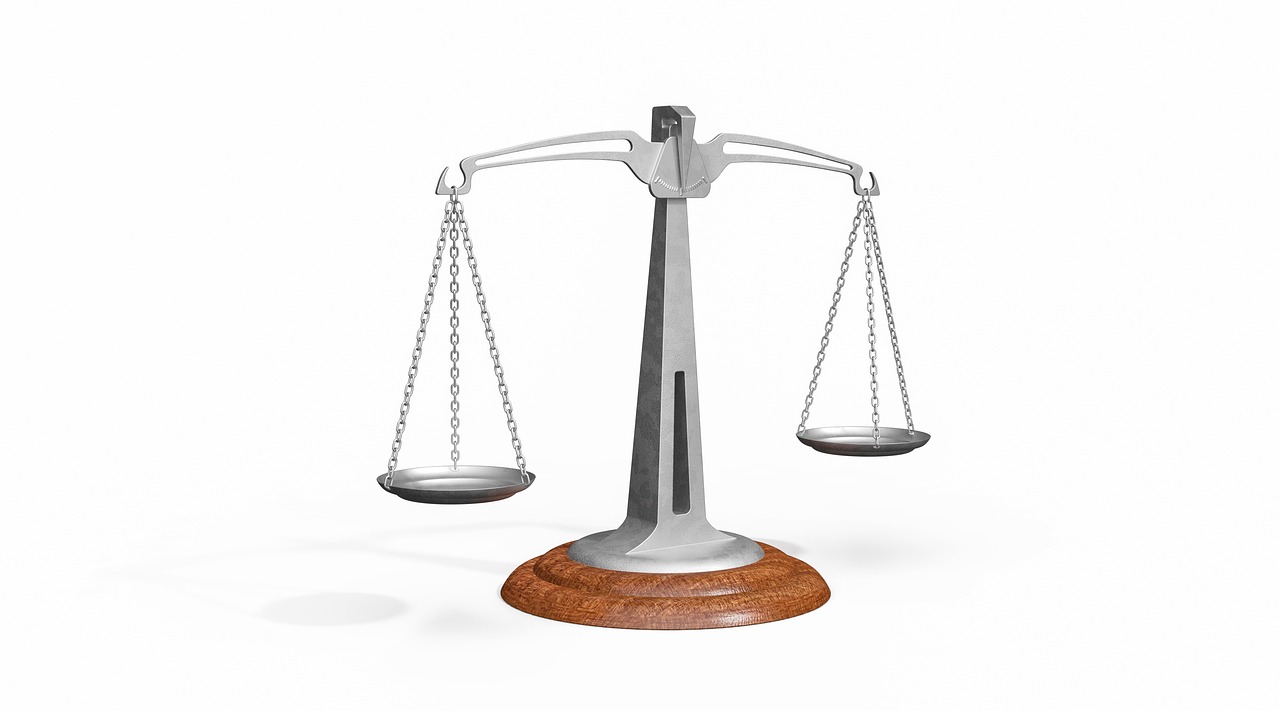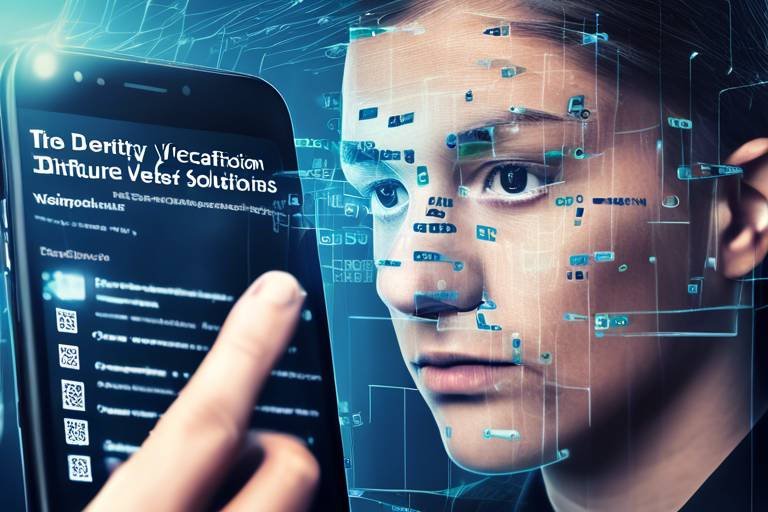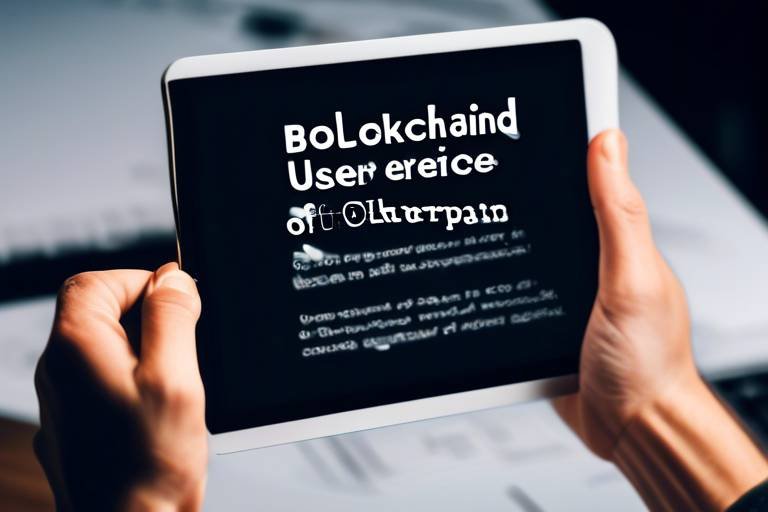The Future of Identity Verification - Blockchain-Based Solutions
In a world where digital interactions are becoming the norm, the importance of secure and reliable identity verification cannot be overstated. Traditional methods, such as passwords and personal identification numbers, are increasingly vulnerable to breaches and fraud. Enter blockchain technology, a revolutionary approach that promises to transform the way we verify identities. Imagine a world where your personal information is not only secure but also entirely under your control. This article explores the transformative potential of blockchain technology in identity verification, highlighting its benefits, challenges, and future prospects in enhancing security and privacy.
At its core, blockchain is a decentralized digital ledger that records transactions across many computers in such a way that the registered transactions cannot be altered retroactively. This technology is the backbone of cryptocurrencies like Bitcoin, but its applications extend far beyond digital currencies. In the realm of identity verification, blockchain offers a secure and transparent way to store and manage identity data. Each participant in the network has access to the same information, which eliminates discrepancies and enhances trust. The foundational principles of blockchain—transparency, security, and decentralization—are precisely what make it a game-changer for identity verification.
The integration of blockchain in identity verification presents numerous advantages that can significantly improve the current systems in place. These include:
- Enhanced Security: Blockchain's decentralized nature provides robust security features that protect against unauthorized access and data breaches.
- Reduced Fraud: The transparent and immutable nature of blockchain records makes it exceedingly difficult for fraudsters to manipulate identity information.
- Increased User Control: Users have greater control over their personal information, deciding who can access it and when.
One of the most compelling aspects of blockchain technology is its enhanced security features. With traditional identity verification methods, sensitive data is often stored in central databases, making it a prime target for cyberattacks. In contrast, blockchain's decentralized structure means that data is distributed across a network of computers, making unauthorized access much more difficult. This section examines how these features contribute to safer identity verification processes and why they are crucial in today’s digital landscape.
The immutability of blockchain records is a game-changer for identity verification. Once data is entered into the blockchain, it cannot be altered or deleted. This characteristic is crucial for maintaining the integrity of identity verification systems. Imagine a world where your identity records are not only secure but also unchangeable without your consent. This level of security builds confidence among users, as they can be assured that their identity information remains intact and trustworthy.
Decentralization eliminates the need for a central authority, which fosters trust among users. In a blockchain-based identity verification system, trust is built through transparency and shared control. Users can verify their identity without relying on a single entity, which often has conflicting interests. This section discusses how this trust is essential for the widespread adoption of blockchain-based identity verification and how it can lead to a more secure digital environment.
Blockchain technology empowers users by giving them greater control over their personal data. Unlike traditional systems where personal information is stored and controlled by third parties, blockchain allows individuals to manage their own identity information. This subsection explores how this control enhances privacy and builds user confidence in identity verification systems. Users can choose what information to share and with whom, making it a more personalized and secure experience.
Despite its potential, the implementation of blockchain for identity verification faces several challenges. These include scalability, regulatory compliance, and user adoption. This section highlights these hurdles and potential solutions, ensuring a comprehensive understanding of the landscape.
As blockchain networks grow, scalability becomes a pressing concern. The technical challenges associated with scaling blockchain solutions for identity verification can hinder their effectiveness. This subsection discusses potential strategies to address these challenges, such as implementing sharding or layer-two solutions to improve transaction speeds and reduce congestion.
Navigating the regulatory landscape is crucial for blockchain identity solutions. Legal challenges and compliance requirements must be considered for successful implementation. This section examines how organizations can work with regulators to create frameworks that support innovation while ensuring user protection.
The future of identity verification is likely to be shaped by ongoing advancements in blockchain technology. Emerging trends and innovations could redefine how identities are verified, leading to more secure and user-friendly systems. This section discusses the implications of these trends and what they mean for the future.
The convergence of blockchain with other technologies, such as artificial intelligence (AI) and the Internet of Things (IoT), holds promise for more sophisticated identity verification systems. By leveraging these technologies, organizations can create more efficient and secure verification processes. This subsection explores potential synergies and their implications for the future of identity verification.
The shift towards user-centric identity solutions emphasizes individual control and privacy. Blockchain can facilitate this shift by allowing users to manage their own identity information securely. This section discusses how this trend may impact identity verification practices, ultimately leading to a more equitable digital landscape.
1. What is blockchain technology?
Blockchain is a decentralized digital ledger that records transactions across many computers, ensuring that the registered transactions cannot be altered retroactively.
2. How does blockchain improve identity verification?
Blockchain enhances identity verification by providing a secure, transparent, and immutable way to store and manage identity data, reducing the risk of fraud and unauthorized access.
3. What are the main challenges of implementing blockchain for identity verification?
Key challenges include scalability, regulatory compliance, and user adoption, which must be addressed for successful implementation.
4. How does blockchain empower users regarding their personal data?
Blockchain gives users greater control over their personal information, allowing them to decide who can access it and when, enhancing privacy and security.

[Understanding Blockchain Technology]
Blockchain technology is often hailed as a revolutionary force, promising to change the way we handle data across various sectors. At its core, blockchain is a decentralized digital ledger that records transactions across many computers in such a way that the registered transactions cannot be altered retroactively. This means that once data is entered into the blockchain, it is practically immutable, creating a trustless environment where users can verify the authenticity of information without relying on a central authority. Imagine a library where every book is locked away in a vault, but instead of just one keyholder, every reader has a copy of the key. This is the essence of blockchain—everyone has access to the same information, ensuring transparency and trust.
The fundamental principles of blockchain technology can be broken down into a few key components:
- Decentralization: Unlike traditional systems that rely on a central server, blockchain distributes data across a network of computers, or nodes. This reduces the risk of single points of failure and enhances security.
- Transparency: Every participant in the network can access the entire history of transactions, making it easy to trace back through the data.
- Consensus Mechanisms: To validate transactions, blockchain employs various consensus algorithms (like Proof of Work or Proof of Stake), ensuring that all participants agree on the state of the ledger.
- Smart Contracts: These are self-executing contracts with the terms of the agreement directly written into code. They automatically enforce and execute the terms of the agreement when conditions are met.
When it comes to identity verification, blockchain's architecture offers a promising solution. It allows individuals to own and control their identity data, reducing the risk of identity theft and fraud. By leveraging blockchain, users can create a digital identity that is not only secure but also easily verifiable by others without needing to expose sensitive personal information. This is akin to having a digital passport that can be presented to verify your identity without revealing every detail of your life. In a world where data breaches are increasingly common, this capability is not just beneficial; it’s essential.
In summary, understanding blockchain technology is crucial for appreciating its potential in identity verification. Its decentralized nature, coupled with transparency and security features, positions it as a formidable tool in creating reliable and user-centric identity solutions. As we delve deeper into the benefits and challenges of implementing blockchain for identity verification, it becomes clear that this technology is not just a trend; it’s a paradigm shift that could redefine how we think about and manage identity in the digital age.

[Benefits of Blockchain for Identity Verification]
The integration of blockchain technology into identity verification systems is not just a trend; it's a revolutionary shift that brings a plethora of benefits. Imagine a world where your personal information is not only secure but also entirely within your control. This is the promise of blockchain. One of the most significant advantages is enhanced security. Traditional identity verification methods are often plagued by data breaches and fraud. However, blockchain's decentralized nature creates a fortress around your identity data, making it incredibly difficult for hackers to penetrate. With every transaction recorded on a public ledger, the chances of unauthorized access decrease dramatically.
Moreover, the concept of user control is taken to new heights. In a blockchain-based identity system, individuals can manage their own information rather than relying on third-party organizations. This not only enhances privacy but also builds trust. Users can decide who accesses their data and for what purpose, eliminating the anxiety that comes with sharing personal information. For instance, instead of providing your entire identity to a service provider, you can share only the necessary data, such as age or location, while keeping other details private.
Another noteworthy benefit is the reduction of fraud. With traditional systems, identity theft is a significant risk. In contrast, blockchain's immutable records ensure that once your identity is verified, it cannot be tampered with. This characteristic is essential in preventing fraudulent activities. Imagine a bank that can verify your identity without the need for multiple documents and lengthy processes. With blockchain, this can be achieved in mere seconds, making the verification process not only faster but also more reliable.
To summarize, the benefits of blockchain for identity verification can be encapsulated in the following points:
- Enhanced Security: Protects against unauthorized access and data breaches.
- User Control: Empowers users to manage their own data.
- Reduced Fraud: Immutable records prevent identity theft.
- Efficiency: Speeds up the verification process, making it more reliable.
In conclusion, the transition to blockchain-based identity verification systems offers a promising future characterized by security, control, and efficiency. As more organizations begin to recognize these benefits, we can expect a gradual shift towards adopting these innovative solutions, paving the way for a safer digital landscape.
Q1: How does blockchain enhance security in identity verification?
A1: Blockchain enhances security by decentralizing data storage, making it much harder for hackers to access and manipulate personal information. Each transaction is recorded on a public ledger, providing transparency and accountability.
Q2: Can users control who accesses their identity data?
A2: Yes! Blockchain technology allows users to have complete control over their personal information. They can decide who can access their data and for what purpose, enhancing privacy and security.
Q3: What role does immutability play in preventing fraud?
A3: The immutability of blockchain records means that once data is entered, it cannot be altered or deleted. This characteristic is crucial for maintaining the integrity of identity verification, thereby significantly reducing the risk of identity theft and fraud.
Q4: Is blockchain technology scalable for widespread use in identity verification?
A4: While scalability is a challenge, ongoing advancements in blockchain technology are addressing these issues. Solutions are being developed to ensure that blockchain can handle increased transaction volumes without compromising performance.

[Enhanced Security Features]
The world today is buzzing with concerns about data breaches and identity theft. With traditional identity verification methods often falling prey to security vulnerabilities, it’s no wonder that organizations are looking for more robust solutions. Enter blockchain technology, a game-changer that promises to revolutionize the way we secure our identities. But what makes blockchain so secure? Let's dive into its enhanced security features.
At its core, blockchain operates on a decentralized network, which means that no single entity has control over the entire system. This decentralization is a crucial factor in enhancing security. Unlike traditional databases, where a central point of failure can be exploited, blockchain distributes data across multiple nodes. This makes it significantly harder for malicious actors to manipulate or access sensitive information. Imagine a vault that is spread out across numerous locations instead of being locked in a single room—this is essentially how blockchain protects your identity.
Another key feature of blockchain is its immutable nature. Once data is recorded on a blockchain, it cannot be altered or deleted without the consensus of the network. This immutability is vital for maintaining the integrity of identity verification systems. For instance, if a person’s identity information is verified and stored on a blockchain, any attempt to change this data would require altering it on every single node in the network. This is not only time-consuming but practically impossible, thus ensuring that your identity remains safe from tampering.
Moreover, blockchain utilizes advanced cryptographic techniques to secure data. Each transaction is encrypted and linked to the previous one, forming a secure chain. This means that even if someone were to intercept the data, they would find it nearly impossible to decipher it without the proper cryptographic keys. In a world where cyber threats are constantly evolving, blockchain’s use of cryptography is like having an unbreakable code that protects your identity from prying eyes.
Additionally, blockchain enhances security through the use of smart contracts. These self-executing contracts with the terms of the agreement directly written into code can automate the verification process. For example, a smart contract can automatically validate your identity when you attempt to access a service, ensuring that only authorized users can gain access. This not only speeds up the verification process but also reduces the risk of human error, which is often a weak link in traditional systems.
To summarize, the enhanced security features of blockchain technology provide a robust framework for identity verification. Here are the key points:
- Decentralization: Reduces the risk of a single point of failure.
- Immutability: Ensures data integrity and prevents tampering.
- Cryptographic Security: Protects data from unauthorized access.
- Smart Contracts: Automates and secures the verification process.
As we look to the future, it's clear that these enhanced security features will play a pivotal role in building trust in identity verification systems. With the stakes higher than ever, adopting blockchain technology could be the key to safeguarding our identities in an increasingly digital world. Are you ready to embrace this technological revolution?

[Immutable Records]
One of the most compelling features of blockchain technology is its ability to create immutable records. But what does this really mean? In simple terms, once data is entered into a blockchain, it becomes nearly impossible to alter or delete. This characteristic is crucial for maintaining the integrity of identity verification systems, as it ensures that the information remains accurate and trustworthy over time.
Imagine a traditional identity verification system, where records can be easily manipulated or erased. This creates a fertile ground for fraud and identity theft. On the other hand, blockchain acts like a digital fortress, where every transaction is securely locked in place. Each block in the chain contains a unique cryptographic hash of the previous block, along with a timestamp and transaction data. This interlinking makes it nearly impossible for anyone to tamper with the information without being detected.
To illustrate the significance of immutable records, consider the following key points:
- Trustworthiness: Users can trust that their data hasn’t been altered by unauthorized parties.
- Accountability: If a mistake occurs, it can be traced back to the original entry, allowing for accountability.
- Auditability: Immutable records enable easier auditing processes, as every change is documented and visible.
This immutability is not just a technical feature; it fundamentally changes the way we think about identity verification. It builds a foundation of trust among users, service providers, and regulatory bodies. In a world increasingly concerned with data breaches and privacy violations, the promise of immutable records offers a beacon of hope, suggesting that we can have systems that are not only secure but also transparent.
However, it’s important to note that while blockchain provides these robust features, it is not a silver bullet. Organizations must still implement proper governance and security protocols to ensure that the data entered into the blockchain is accurate in the first place. The immutability of records is only as good as the data being recorded.
In conclusion, the concept of immutable records is a game-changer for identity verification. It not only enhances security but also fosters a new level of trust among users and service providers. As we continue to explore the potential of blockchain technology, the importance of maintaining the integrity of identity data will only grow.
- What are immutable records? Immutable records are data entries on a blockchain that cannot be altered or deleted once they are created.
- How do immutable records enhance security? They prevent unauthorized changes to data, making it difficult for fraudsters to manipulate identity information.
- Can immutable records be audited? Yes, the transparency of blockchain allows for easy auditing of all transactions and changes made.
- What happens if incorrect data is entered? While the data cannot be changed, it can be traced back to the original entry, allowing for accountability and correction through new entries.

[Decentralization and Trust]
Decentralization is one of the most compelling aspects of blockchain technology, and it plays a crucial role in fostering trust among users. Imagine a world where your identity is not controlled by a single entity, like a bank or government; instead, it is distributed across a network of computers. This is the essence of decentralization. By removing the central authority, blockchain creates an environment where individuals can interact directly with one another, leading to increased transparency and accountability.
When we talk about trust in the context of identity verification, it’s important to understand that traditional systems rely heavily on centralized authorities. These authorities can be prone to errors, fraud, and data breaches. In contrast, blockchain's decentralized framework ensures that no single party has complete control over the data. This significantly reduces the risk of manipulation and enhances the credibility of the information being verified.
Moreover, the decentralized nature of blockchain means that every transaction is recorded on multiple nodes across the network. This creates a transparent ledger that is accessible to all participants. If someone tries to tamper with the data, the changes would be evident to everyone, making it almost impossible to alter the information without detection. This level of transparency is revolutionary, as it builds a foundation of trust among users, who can feel confident that their identity information is secure and accurate.
To illustrate the importance of decentralization in building trust, consider the following points:
- Elimination of Single Points of Failure: In a decentralized system, the failure of one node does not compromise the entire network. This resilience enhances trust.
- Peer-to-Peer Interactions: Users can transact directly with one another, reducing reliance on intermediaries and the associated risks.
- Consensus Mechanisms: Transactions must be validated by multiple parties, ensuring that all participants agree on the state of the ledger before changes are made.
As we move towards a more digital future, the importance of decentralization in identity verification cannot be overstated. It not only enhances security but also cultivates an atmosphere where users feel empowered and in control of their personal information. This shift in mindset is essential for the widespread adoption of blockchain-based identity solutions, paving the way for a more secure and trustworthy digital landscape.
Q1: What is decentralization in blockchain?
A1: Decentralization in blockchain refers to the distribution of data across a network of computers, eliminating the need for a central authority to manage and control the information.
Q2: How does decentralization enhance trust?
A2: By removing a central authority and allowing peer-to-peer interactions, decentralization increases transparency and reduces the risk of fraud, thereby enhancing trust among users.
Q3: What are the benefits of using blockchain for identity verification?
A3: Benefits include improved security, reduced fraud, user control over personal data, and the creation of immutable records that ensure data integrity.
Q4: Are there any challenges to implementing decentralized identity solutions?
A4: Yes, challenges include scalability, regulatory compliance, and user adoption, all of which need to be addressed for successful implementation.

[User Control and Privacy]
In today’s digital landscape, where data breaches and privacy concerns are rampant, user control and privacy are more important than ever. Blockchain technology offers a revolutionary approach to managing personal information, giving users the power to control who accesses their data and how it’s used. Imagine a world where you hold the keys to your identity, deciding when and with whom to share your information. This is not just a dream; it’s the promise of blockchain.
One of the standout features of blockchain is its ability to create a decentralized identity. Unlike traditional systems where a central authority holds your data, blockchain allows you to store your identity securely on a distributed ledger. This means that no single entity can manipulate or access your information without your consent. It’s a bit like having a vault for your identity that only you can unlock. With this level of control, users can feel more secure and confident in sharing their information.
Moreover, blockchain enhances privacy through cryptographic techniques. Each transaction or data entry is encrypted, ensuring that even if someone were to access the blockchain, they wouldn’t be able to read your personal information without the proper keys. This privacy mechanism is crucial, especially when considering sensitive data like health records or financial information. It’s akin to sending a letter in a locked box that only the intended recipient can open.
Additionally, blockchain facilitates the concept of selective disclosure. Users can choose what information to share and with whom, allowing for tailored interactions. For instance, when applying for a job, you might only want to share your qualifications and not your entire employment history. With blockchain, you can do just that, maintaining your privacy while still providing necessary information. This selective sharing is a game-changer, as it allows users to engage with services without exposing their entire identity.
However, while the benefits of user control and privacy in blockchain are clear, it’s essential to recognize that this new paradigm also comes with responsibilities. Users must be aware of how to manage their digital identities effectively. This might involve understanding the implications of sharing certain data or knowing how to recover their identity in case of loss. Therefore, education and awareness are crucial components of the blockchain identity landscape.
In summary, blockchain technology not only empowers users with greater control over their personal information but also enhances privacy through decentralized storage and cryptographic security. As we move towards a more digital-centric world, embracing these innovations will be essential for protecting our identities and ensuring our personal information remains just that—personal.
- What is blockchain technology?
Blockchain technology is a decentralized digital ledger that securely records transactions across multiple computers, ensuring that the data cannot be altered retroactively.
- How does blockchain enhance user control over personal data?
Blockchain allows users to manage their identity and personal data without relying on a central authority, empowering them to decide what information to share and with whom.
- Is my personal information safe on a blockchain?
Yes, blockchain uses cryptographic techniques to secure data, making it difficult for unauthorized users to access or alter personal information.
- What is selective disclosure in blockchain?
Selective disclosure allows users to share only specific pieces of their identity information, rather than their entire data set, enhancing privacy.

[Challenges in Implementing Blockchain Solutions]
While the potential of blockchain technology in identity verification is undeniably exciting, it's essential to recognize that the road to implementation is fraught with challenges. These hurdles can be likened to navigating a complex maze—each turn presents new obstacles that must be carefully considered and addressed. Among the most pressing challenges are scalability, regulatory compliance, and user adoption. Let's dive deeper into these issues to understand their implications.
One of the primary challenges is scalability. As blockchain networks expand, the volume of transactions and data increases significantly. This growth can lead to congestion and slow processing times, which are particularly problematic for identity verification systems that require quick and efficient responses. For instance, imagine standing in line at a coffee shop, waiting for your turn to order. If the barista is overwhelmed and slow, your experience becomes frustrating. Similarly, if a blockchain identity verification system cannot handle a high volume of requests, it risks losing user trust and acceptance.
To address scalability issues, developers are exploring various solutions, such as implementing layer-2 scaling solutions or optimizing consensus mechanisms. These strategies aim to enhance the network's capacity while maintaining the security and integrity of the data. However, the implementation of these solutions is not straightforward and requires significant technical expertise and resources.
Another significant hurdle is regulatory and compliance concerns. The legal landscape surrounding blockchain technology is still evolving, and many jurisdictions have yet to establish clear guidelines for its use, especially concerning identity verification. Organizations looking to implement blockchain solutions must navigate a patchwork of regulations that can vary widely from one region to another. This complexity can be likened to trying to follow a recipe without having all the ingredients on hand—it's challenging to create a successful dish without knowing what rules to follow.
Moreover, compliance with data protection laws, such as the General Data Protection Regulation (GDPR) in Europe, poses additional challenges. For instance, the immutability of blockchain records can conflict with the right to be forgotten, a key provision of GDPR. This tension requires careful consideration and innovative solutions to ensure that blockchain identity verification systems can operate within legal frameworks while still providing the benefits of decentralization.
Lastly, user adoption remains a critical challenge. Even the most promising technology can falter without widespread acceptance. Many potential users may be hesitant to embrace blockchain-based identity verification due to a lack of understanding or fear of the unknown. Imagine trying to convince someone to switch from a traditional bank to a cryptocurrency wallet; if they are not familiar with the technology, they may resist the change. To foster adoption, it is vital to educate users about the benefits of blockchain, such as enhanced security and control over personal data.
In summary, while the challenges of implementing blockchain solutions for identity verification are significant, they are not insurmountable. By addressing scalability issues, navigating regulatory complexities, and promoting user adoption through education and outreach, we can pave the way for a future where blockchain technology revolutionizes how we verify identities. As we continue to explore this transformative technology, it’s crucial to remain vigilant and proactive in overcoming these challenges.
- What are the main challenges of implementing blockchain for identity verification? The primary challenges include scalability issues, regulatory compliance, and user adoption.
- How does scalability affect blockchain identity verification? Scalability can lead to slow processing times and congestion, which can frustrate users and reduce trust in the system.
- What are the regulatory concerns surrounding blockchain? The evolving legal landscape and potential conflicts with data protection laws, such as GDPR, pose significant challenges for compliance.
- How can user adoption be increased for blockchain identity verification? Educating users about the benefits of blockchain technology and addressing their concerns can help foster greater acceptance.

[Scalability Issues]
As we dive deeper into the world of blockchain technology, one of the most pressing concerns that arises is scalability. Imagine a bustling city where every transaction, every movement, and every interaction is meticulously recorded. Now, picture that city growing exponentially, with more people moving in and more businesses opening up. This is akin to how blockchain networks function. As the number of users and transactions increases, the ability of the blockchain to process these transactions efficiently can become strained. The fundamental architecture of many blockchain systems, particularly those that rely on proof-of-work mechanisms, can lead to slow processing times and high transaction fees.
To put it simply, scalability issues can be likened to a traffic jam during rush hour. Just as cars struggle to move smoothly on a congested highway, blockchain transactions can become bottlenecked as more users attempt to access the network simultaneously. This can lead to delays in transaction confirmations and a frustrating experience for users who expect quick and seamless identity verification.
Moreover, the need for scalability is not just about handling more transactions; it’s also about maintaining the integrity and security of the data being processed. When networks become overloaded, there’s a risk of compromising the very features that make blockchain appealing in the first place. For instance, if a blockchain network cannot handle a surge in identity verification requests, it may resort to temporary solutions that could introduce vulnerabilities.
Here are some of the main challenges associated with scalability:
- Transaction Speed: As more users join the network, the time it takes to process each transaction can increase significantly.
- Network Congestion: High volumes of transactions can lead to congestion, causing delays and higher fees.
- Resource Intensity: Some blockchain solutions require significant computational power, which can be a barrier for widespread adoption.
To tackle these scalability challenges, several strategies are being explored:
- Layer 2 Solutions: Technologies such as the Lightning Network or sidechains can help alleviate congestion by processing transactions off the main blockchain.
- Sharding: This involves breaking down the blockchain into smaller, more manageable pieces, allowing for parallel processing and increased transaction throughput.
- Alternative Consensus Mechanisms: Moving away from proof-of-work to more efficient systems like proof-of-stake can significantly enhance scalability.
In conclusion, while scalability remains a significant hurdle for blockchain-based identity verification systems, ongoing innovations and research hold promise for overcoming these challenges. By implementing effective solutions, we can pave the way for a more efficient and robust identity verification landscape that harnesses the full potential of blockchain technology.
Q1: What are the main challenges of blockchain scalability?
A1: The main challenges include transaction speed, network congestion, and resource intensity, which can hinder the efficiency of blockchain networks.
Q2: How can scalability issues be addressed?
A2: Solutions include Layer 2 technologies, sharding, and adopting alternative consensus mechanisms like proof-of-stake.
Q3: Why is scalability important for identity verification?
A3: Scalability is crucial because it ensures that identity verification processes remain fast, reliable, and secure, even as the number of users increases.

[Regulatory and Compliance Concerns]
The implementation of blockchain technology in identity verification is not without its challenges, particularly when it comes to regulatory and compliance issues. As governments and regulatory bodies around the world grapple with the implications of decentralized systems, the landscape of compliance can often seem murky and complex. One of the primary concerns is that blockchain operates across borders, which complicates the application of local laws and regulations. For instance, what happens when a user from one country interacts with a blockchain system that is governed by the laws of another? This question remains largely unanswered and poses a significant hurdle for widespread adoption.
Additionally, the data protection regulations such as the General Data Protection Regulation (GDPR) in Europe mandate strict guidelines on how personal data should be handled. Blockchain's inherent immutability can clash with these regulations, particularly the right to be forgotten. If a user requests their data to be deleted, the challenge lies in the fact that once data is on the blockchain, it cannot be easily removed. This creates a tension between the benefits of blockchain technology and existing legal frameworks, necessitating a careful balancing act.
Furthermore, organizations looking to adopt blockchain solutions must also consider the need for compliance frameworks. These frameworks must not only align with current regulations but also anticipate future changes in the legal landscape. Companies must invest in legal expertise to navigate these waters, ensuring that their blockchain implementations do not inadvertently violate laws. This can create a barrier to entry for smaller organizations that may lack the resources to effectively manage compliance.
To tackle these regulatory challenges, there is a growing movement towards creating standardized compliance protocols specifically designed for blockchain applications. This could involve collaboration between industry stakeholders and regulatory bodies to establish clear guidelines that can facilitate the safe use of blockchain technology in identity verification. For instance, initiatives like the Blockchain Research Institute are working to bridge the gap between technology and regulation, advocating for a framework that fosters innovation while ensuring protection for users.
In conclusion, while blockchain technology holds immense potential for revolutionizing identity verification, its success hinges on addressing regulatory and compliance concerns. As the technology continues to evolve, so too must the legal frameworks that govern it. Stakeholders must remain proactive in engaging with regulators to develop solutions that not only meet compliance requirements but also support the transformative vision of blockchain for identity verification.
- What are the main regulatory challenges facing blockchain identity verification?
Key challenges include data protection laws, cross-border legal complexities, and the need for compliance frameworks.
- How does blockchain technology ensure compliance with data protection regulations?
Blockchain can enhance compliance through transparency and traceability, but its immutability poses challenges for regulations like GDPR.
- What steps can organizations take to navigate compliance issues?
Organizations should invest in legal expertise, develop standardized compliance protocols, and engage with regulators to ensure alignment with laws.

[Future Trends in Identity Verification]
The future of identity verification is not just a fleeting notion; it's an evolving landscape that promises to reshape how we authenticate ourselves in a digital world. With the ongoing advancements in blockchain technology, we are on the brink of a revolution that could redefine the very essence of identity verification. Imagine a world where your digital identity is not just a string of numbers and letters but a secure, immutable record that you control. This is not science fiction; this is the future we're heading towards.
One of the most exciting trends is the integration of blockchain with other emerging technologies. As we witness the rise of Artificial Intelligence (AI) and the Internet of Things (IoT), their convergence with blockchain could lead to highly sophisticated identity verification systems. For instance, AI can analyze patterns and detect anomalies in identity verification processes, while IoT devices can gather real-time data to enhance security. Together, these technologies can create an ecosystem where identity verification is not only secure but also seamless and user-friendly.
Moreover, there's a growing emphasis on user-centric identity solutions. In an age where data privacy is paramount, users are demanding more control over their personal information. Blockchain technology empowers individuals by allowing them to manage their data, share it selectively, and revoke access when necessary. This shift towards user-centric solutions not only enhances privacy but also builds trust between users and service providers. It’s akin to having a key to your own digital vault, where you decide who gets to peek inside.
As we look ahead, we can expect to see the emergence of decentralized identity (DID) systems that further empower users. These systems will allow individuals to create and manage their own digital identities without relying on centralized authorities. Imagine being able to carry your identity with you, like a digital passport, that you can present whenever needed, without the fear of it being misused. This level of control is revolutionary and could significantly reduce identity theft and fraud.
Additionally, the regulatory landscape will play a crucial role in shaping the future of identity verification. As blockchain solutions gain traction, regulators will need to keep pace with technological advancements. This could lead to the establishment of new frameworks that not only ensure compliance but also foster innovation. The challenge will be to strike a balance between protecting user privacy and enabling the growth of blockchain-based identity solutions.
Finally, as we embrace these trends, education and awareness will be vital. Users must understand the benefits and functionalities of blockchain-based identity verification to fully leverage its potential. This could involve initiatives from both the private and public sectors to educate users about their rights and the importance of safeguarding their digital identities.
- What is blockchain technology?
Blockchain is a decentralized digital ledger that securely records transactions across multiple computers. It ensures that the recorded data cannot be altered retroactively without the consensus of the network. - How does blockchain enhance identity verification?
Blockchain enhances identity verification by providing a secure, immutable, and transparent way to store and manage identity data, reducing the risk of fraud and unauthorized access. - What are decentralized identity systems?
Decentralized identity systems allow individuals to create and manage their own digital identities without relying on a central authority, giving users more control over their personal information. - What role do regulations play in blockchain identity verification?
Regulations are essential for ensuring compliance and fostering innovation in blockchain identity solutions. They help protect user privacy while enabling the growth of new technologies.

[Integration with Other Technologies]
As we venture deeper into the digital age, the integration of blockchain technology with other cutting-edge technologies is becoming increasingly vital. Imagine a world where your identity is not only verified through blockchain but also enhanced by the capabilities of Artificial Intelligence (AI) and the Internet of Things (IoT). This convergence opens up a realm of possibilities that could redefine how we manage and secure our identities.
For instance, AI can analyze vast amounts of data to detect patterns and anomalies, which can significantly bolster the security of blockchain-based identity verification systems. By using AI algorithms, we can identify potential fraud attempts in real-time, ensuring that only legitimate users gain access to sensitive information. This combination of AI's analytical prowess and blockchain's immutable records creates a formidable defense against identity theft and fraud.
Moreover, the IoT plays a crucial role in this integration. With the growing number of connected devices, from smart home appliances to wearable technology, the potential for seamless identity verification becomes a reality. Imagine walking into a secure facility, and your identity is automatically verified through a combination of biometric data captured by your smartwatch and the blockchain's secure database. This not only enhances user convenience but also significantly improves security protocols.
However, the integration of these technologies is not without its challenges. Data privacy concerns arise when multiple technologies interact, and ensuring that personal information remains secure is paramount. Therefore, creating robust frameworks that govern how these technologies work together is essential. It is crucial to establish standards that protect user data while allowing for innovation.
To illustrate the potential benefits of integrating blockchain with AI and IoT, consider the following table:
| Technology | Benefit | Example |
|---|---|---|
| Blockchain | Immutable identity records | Secure storage of personal data |
| AI | Fraud detection and prevention | Real-time monitoring of user behavior |
| IoT | Seamless identity verification | Biometric data from wearable devices |
In conclusion, the integration of blockchain with AI and IoT presents a transformative opportunity for identity verification systems. By harnessing the strengths of each technology, we can create a more secure, efficient, and user-friendly identity management process. As we continue to innovate and address the challenges that arise, the future of identity verification looks incredibly promising.
- What is blockchain technology? Blockchain is a decentralized digital ledger that records transactions across multiple computers, ensuring that the data is secure and cannot be altered retroactively.
- How does AI enhance blockchain identity verification? AI can analyze user data to detect anomalies and potential fraud, providing an additional layer of security to blockchain identity systems.
- What role does IoT play in identity verification? IoT devices can collect biometric data and facilitate seamless identity verification processes, improving user experience and security.
- What are the main challenges in integrating these technologies? Key challenges include data privacy concerns, regulatory compliance, and the need for robust frameworks to govern the interaction between these technologies.

[User-Centric Identity Solutions]
In an era where data breaches and privacy concerns are at the forefront of public discourse, user-centric identity solutions are emerging as a game-changer in the realm of identity verification. Imagine a world where you have total control over your personal information, where you decide who gets to see what, and where your identity is protected by the very technology that empowers you. This is the promise that blockchain holds for identity verification.
The essence of user-centric identity solutions lies in the idea of self-sovereign identity. This concept allows individuals to own and manage their identity data without relying on a centralized authority. Instead of having to navigate through a maze of third-party services, users can directly control their information. This not only enhances privacy but also builds trust, as users can verify their identities without exposing unnecessary data.
As we delve deeper into this concept, it's essential to understand how blockchain facilitates these user-centric approaches. With blockchain, identity verification becomes a seamless experience. Users can create digital identities that are cryptographically secured, allowing them to share only the information that is relevant to a specific transaction or interaction. For instance, when signing up for a new service, instead of providing your entire identity, you can simply share a cryptographic proof that verifies your age or residency without revealing your full name or address.
This level of control is not just a theoretical concept; it has real-world implications. Many organizations are beginning to adopt blockchain-based identity solutions that prioritize the user experience. For example, companies in the financial sector are leveraging these technologies to streamline onboarding processes while ensuring compliance with regulatory requirements. By enabling customers to verify their identities using blockchain, these companies can reduce fraud and enhance customer satisfaction.
Furthermore, the integration of user-centric identity solutions with emerging technologies like Artificial Intelligence (AI) and the Internet of Things (IoT) can lead to even more sophisticated systems. Imagine an AI-driven platform that analyzes your identity data and provides personalized recommendations based on your preferences, all while keeping your information secure and private. This synergy between technologies can redefine identity verification practices, making them not only more secure but also more user-friendly.
However, while the potential is immense, it's crucial to address the challenges that come with implementing these solutions. User adoption is a significant hurdle; many users may be hesitant to embrace new technologies, especially when it comes to something as sensitive as their identity. Education and awareness are key to overcoming these barriers. As users become more informed about the benefits of self-sovereign identity and the security that blockchain offers, they will be more likely to adopt these solutions.
In conclusion, user-centric identity solutions represent a pivotal shift in how we approach identity verification. By placing control back in the hands of individuals, blockchain technology not only enhances security and privacy but also fosters a new level of trust between users and organizations. As we continue to innovate and refine these systems, the future of identity verification looks promising, with users at the heart of the transformation.
- What is a self-sovereign identity? A self-sovereign identity allows individuals to own and control their identity data without relying on a central authority.
- How does blockchain enhance identity verification? Blockchain provides a secure and transparent way to store identity data, ensuring that it cannot be altered or deleted.
- What are the benefits of user-centric identity solutions? These solutions enhance privacy, increase user control over personal data, and build trust between users and organizations.
- What challenges exist in implementing these solutions? Challenges include user adoption, scalability, and navigating regulatory compliance.
Frequently Asked Questions
- What is blockchain technology and how does it relate to identity verification?
Blockchain technology is a decentralized digital ledger that securely records transactions across many computers. In the realm of identity verification, it offers a reliable way to store and manage identity data, ensuring that information is both secure and transparent. This means that individuals can verify their identity without relying on a central authority, which can often be a single point of failure.
- What are the main benefits of using blockchain for identity verification?
There are several key benefits to using blockchain for identity verification, including enhanced security, reduced risk of fraud, and increased control for users over their personal information. By leveraging blockchain's decentralized and immutable nature, users can trust that their data is protected against unauthorized access and breaches, while also having the ability to manage who can see their information.
- How does blockchain enhance security in identity verification?
Blockchain enhances security through its decentralized structure, which makes it much harder for hackers to compromise the system. Each transaction is encrypted and linked to the previous one, creating a chain of records that cannot be altered without consensus from the network. This means that once identity data is entered, it remains secure and tamper-proof, significantly reducing the chances of identity theft.
- What challenges does blockchain face in identity verification?
Despite its advantages, blockchain technology faces several challenges in implementation, such as scalability issues, regulatory compliance, and user adoption. As the number of users and transactions grows, maintaining speed and efficiency becomes crucial. Additionally, navigating the complex regulatory landscape can be daunting for developers looking to create compliant solutions.
- What does the future hold for blockchain-based identity verification?
The future of blockchain in identity verification is promising, with trends pointing towards greater integration with technologies like AI and IoT. This convergence could lead to even more sophisticated identity verification systems that prioritize user control and privacy. As individuals demand more secure and user-centric solutions, blockchain is likely to play a pivotal role in shaping these innovations.
- How does user control over personal data work in blockchain identity solutions?
In blockchain identity solutions, users have greater control over their personal data compared to traditional systems. They can choose what information to share, with whom, and for how long. This empowerment not only enhances privacy but also builds trust, as users can manage their identities without relying on third-party organizations that may mishandle their data.



















